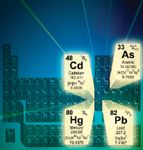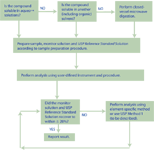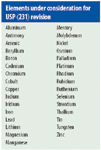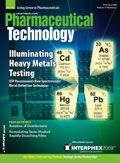News
Article
Pharmaceutical Technology
Illuminating Heavy Metals Testing
USP <231> Heavy Metals is transitioning toward the incorporation of modern quantitative technologies, but there is still much to be resolved.
A stimuli article calling for revised methods for detecting heavy metals impurities in drug substances and drug products has been applauded for addressing an issue long overdue and has prompted much needed discussion (1). While the details of the article replacing the nearly 100-year-old USP–NF (231) Heavy Metals General Chapter are debated, industry and regulators are actively keeping an eye on its progress. The final chapter will affect makers of drug substances, finished drug products, and raw materials. Factors under consideration include the types of impurities that should be detected, their acceptance limits, and the analytical tools for quantitative assessment.

(ILLUSTRATION: M.MCEVOY IMAGES: CASPER BENSON, DAVID FREUND/GETTY IMAGES)
Impurity detection has received heightened attention since the scandals involving lead in toys, glycerin contamination with diethylene glycol, adulterated heparin, and melamine in pet food and infant formula. A strong impurities screening approach is especially important as an increasing amount of drug substances and excipients are imported from regions outside of the United States. "When FDA has to confront these big problems, it has to start using all the tools at its disposal. Eventually manufacturers will have to know more about what they buy," says Luciano Virgili, former director of global testing standards at Bristol Meyers Squibb.
Problems with current methodology
The USP ‹231› General Chapter screening methods are outdated, nonspecific, and, for the most part, inefficient. The qualitative wet chemistry techniques convert metals to a sulfide and analysts compare the colors of the sample liquid to a standard preparation to determine whether metallic impurities are present. The chapter contains three methods. Method I is used for substances that yield a colorless liquid preparation and involves only dissolving and diluting the substance. Methods II and III, however, are used for substances that do not yield colorless preparations and involve heating the substance, which may result in the loss of some metals and negatively impact the accuracy of the analysis.
"The way the method is run, you can detect 10 different metals while performing the test," says Gayla Velez, director of analytical services at SGS Northview Labs (Northbrook, IL). "But when USP revised the General Chapter a few years ago and they added a monitor to Method II, we found you couldn't recover most of those metals if you spiked it, and then took it through the digestion process. So what concerns me is that we are doing this test on a day-to-day basis, yet we know that we may be losing some of the metals that we are trying to detect."
Industry analysts have reported difficulty with reagents and achieving results with the monitor solutions and standards (2). Moreover, the methods in the current chapter are nonspecific. "One description of it is hitting two rocks together and hoping it's going to tell you the right answer," says Steve Boyajian, business development manager at Activation Labs (Ancaster, Ontario). "You very rarely, if ever, get a positive result from the current test indicating there is metal above the limit. Even if a problem existed, the current test would not be able to detect it."
The stimuli article
The stimuli article (found at http://www.usp.org/pdf/EN/USPNF/2008-04-10InorganicImpuritiesStim.pdf) proposes replacing USP ‹231› with an instrument-based screening method that is more accurate and practical. It proposes expanding the application of USP ‹231› to 31 elements (see sidebar, "Elements under consideration for USP ‹231› revision"), provides a decision tree for determining the means of sample preparation (see Figure 1), lists oral and parenteral limits for each element, and states USP will provide performance-based reference standards depending on whether the test articles are soluble in aqueous solutions, organic solvents, or apply to closed-vessel microwave digestion. However, the stimuli article does not yet include the preparation technique for digesting solid samples, converting them to liquids so that they can be introduced into the instruments.

Figure 1: Decision tree for analytical method selection (1). (FIGURES IS ADAPTED FROM USP.)
The stimuli article also states that to perform a multi-element analysis, an inductively coupled plasma (ICP) spectrometer, either in the atomic (optical) emission or mass spectrometry (MS) mode is "required" (1). ICP–MS is about 1000 times more sensitive (to parts per billion level) than ICP alone (to parts per million level). ICP–MS detects and provides concentration amounts for nearly 60 elements at one time, while ICP alone can detect about 30 elements simultaneously. At the 2008 USP Annual Meeting, however, it was stated that the ICP methods are options for analytical determinations. Analysts are free to validate methods or procedures that work for their sample, including atomic absorption (AA) spectroscopy, which is element specific and as sensitive as optical ICP (2).
Industry concerns
The comment period for the stimuli article ended Dec. 15, 2008. USP plans to issue a draft document by July or August 2009, with the final General Chapter taking effect mid-2010. Most of industry's concerns focused on the following (opinions expressed in this article are those of the individuals and may not represent those of their company or affiliation).
Too many elements. Of the known elements listed in the stimuli article (see sidebar, "Elements under consideration for USP ‹231› revision"), four heavy metals are known to be the greatest toxic threat to humans and to the environment: lead, mercury, cadmium, and arsenic (i.e., "the big four"). Several groups have suggested that USP focus on these four first.

Elements under consideration for USP â¹231⺠revision
"It seems that they are trying to bite off more than they can chew all at once," says David Schoneker, past chairman of IPEC-Americas and member of Pharmaceutical Technology's Editorial Advisory Board. "Many of these individual metals have not undergone any routine testing in the past. You could have a real mess on your hands if suddenly this becomes official and pharmaceutical companies start sending out surveys to suppliers asking whether they meet all of the criteria for all of the metals. In many cases you're going to have supplier companies that will not waste resources to run tests for many of the metals because they feel that there is no chance of it being there based on their understanding of their raw materials and their manufacturing process. However, they may not have any actual test data to back that up and if this is not implemented carefully and for a smaller focused set of metals initially, there may be a lot of confusion about what information is appropriate and necessary to justify the supplier's statements."
During its 2008 annual meeting, USP said it is looking into paring the list of elements down and providing guidance that manufacturers test only for those elements pertinent to their product (2). IPEC–Americas proposes a stepwise approach that focuses on the metals that have the most safety concern to determine their limits and methodologies. Then analysts would assess what other metals need controls and establish appropriate limits and methodologies.
"No one questions there need to be tighter controls on some metals with safety concerns. However, if the full list of 31 metals is incorporated in this initiative all at once, there will be much controversy about whether they all need to be controlled and what the scientifically justified limits need to be in those cases to provide appropriate levels of safety, especially where there may be limited literature information concerning any real safety issues. Let's see how this plays out as we implement the control of the key metals in industry and get everyone on board with thinking about these metals individually and then learn from that and see how the implementation goes," says Schoneker. "We can then add more metals to the list as needed using an organized process so that the implementation for these additional metals provides appropriate control but also works for the industry. Judging from discussions during past stakeholder meetings, we have a sense that USP will not go forward with the way that was specifically proposed in the stimuli article. USP has indicated they will have an Open Forum style meeting in the near future to obtain more information from industry before deciding how to proceed. That is certainly our hope."
Instrumental techniques. The proposal in the stimuli article to replace the entire General Chapter has also been debated. Some experts believe only Methods II and III should be replaced because Method I is still effective for soluble substances. "I think people are saying where simple works, let simple be," says Schoneker. "To our knowledge, no one has shown that there are any problems with using Method I. You are not using any heat or other processes in that method to affect the metal recovery. For simple inorganic material, if you can mix it in water and run a quick sulfide reaction as you do now and you get accurate data that shows you don't have metals present, why not continue with that where it works."
USP indicates the selection of a method should be based on performance using USP reference standards. In particular, "any procedure that provides measurement values within ±20% of the certified concentration for each element in the appropriate USP Reference Standard(s) is considered to be an acceptable procedure to demonstrate compliance" (2).
"USP's intent is not to replace a known specific technology with one that is more specific," says Virgili. "It is just to introduce ICP as an analytical tool and still allow the use of atomic absorption and other techniques, including some spectroscopic techniques in the UV or visible region. If you know what you are looking for and you have the sensitivity and specificity, then it is okay. USP does not exclude anything." However, when it is unknown what, if any, impurities are in a material, such as for some raw materials, drug substances, and excipients, a broader screening may be needed. In such case, the power of ICP or X-ray fluorescence technologies may be needed.
One problem is that ICP is not yet a typical analytical instrument. For some Big Pharma companies and firms making drug substances, where metal impurities may be present, ICP may be a quality control technique, depending on the susceptibility for metal impurities resulting from the processes (e.g., use of catalysts or present in starting materials) and equipment. Many smaller excipient companies and contract laboratories, however, may not yet have ICP or AA instruments. It depends on the likelihood of metals being present in their material, metals that are subject to concern. Some suppliers may have to do a thorough metal screening. In other cases, they will not get that equipment because the concern is not there. These companies are going to have limits to what they will be willing to pay or what they will be willing to do to meet this requirement.
"That is where the challenge is," says Virgili. "Not only do you have to buy this instrumentation, but you are looking nonspecifically for anything. Unless someone tells you, how do you know what to look for? When you buy an excipient that can come from many different suppliers worldwide, the profile of metal impurities from one supplier may be different from another that may be using a different manufacturing method. I don't regard ICP as a routine QC tool for everybody but rather as a tool to learn and monitor. That work does not have to be done in a company laboratory, but it can be delegated to those that can do it better such as third-party laboratories."
Expense. Spectroscopic methods, though substantially more beneficial, are also significantly more expensive. Optical ICP and AA instruments can cost $60,000–100,000 each. Adding an MS component can raise the price to $130,000–160,000, with annual maintenance costs between $5000 and $6000. In addition, operators unfamiliar with the equipment would need at least a week or two of intense training to learn how to find interferences and the relevant emission lines. At a time when companies are cutting their workforce and scaling back expenses, the investment may be difficult to make.
Moreover, ICP–MS for heavy metals uses USP reference standards. "Sometimes USP reference standards may be on backorder and they are very expensive," says Velez. "Another expense is that we always need to have argon, that is what keeps the plasma going, and argon is an expensive gas." SGS now runs ICP for some clients. It currently receives 50–100 samples per month for heavy metals. "If we went from a wet chemistry method to an ICP method, it would at least double the cost. It may be more cost effective based on quantity, but it is a significant expense that [USP] is passing along to the companies that are asking us to do the tests." She adds that conducting an ICP method, however, could eliminate some of the other general chapters that are already in USP such as running separate tests for iron, zinc, and mercury.
Although Virgili agrees that the ICP and AA methods are more expensive, he argues that with more diffusion through the marketplace, the costs may become more reasonable. He points out that the use of reagents with ICP is minimal, quite less than high performance liquid chromatography when the costs to replace the columns, solvents, and recycling these solvents are factored in. "When you look at it in the perspective of a phased-in implementation over a period of say five years, I don't think it is the biggest concern."
Boyajian also points out that pharmaceutical firms may not realize how far the environmental and geological industries have come in using these newer techniques. "The drug industry is focused on the tried and true because that is what we focus on—making sure we are consistent. But some of these cutting-edge techniques are completely ignored for the time being. ICP–MS and ICP both can be done for less than $100 per sample."
Limits. The stimulus article lists the first approximations of the oral limits and parenteral limits for those elements listed in the sidebar. Within industry, however, there is still confusion as to the origin of these limits and why some of these limits disagree with limits already established in other references such as the Food Chemicals Codex and the Code of Federal Regulations requirements for food additives. Industry is also discussing whether these limits apply to substances or finished products. Limits on finished products, for example, would have to take into account dosage, intended use, and the daily exposure information similar to what is used for evaluating residual solvents limits.
Some of these metals are necessary. Iron in dietary supplements, for example, and alumnium, which may go into a pigment for a tablet, can be beneficial. Placing a limit on these elements when they are residuals as opposed to when they are intended components has to be handled separately from limiting metal impurities that are known to be toxic.
"I understand why USP is trying to revise the chapter, but a lot of the limits that USP is proposing are much higher than what they were in the original monograph, so it doesn't make sense that they now allow more than what was allowed individually," says Velez.
Industry discussions are currently trying to address individual metal elements, with appropriate methods and appropriate safety-based limits based on the literature. Comments from the Council of Responsible Nutrition, for example, argue that "irrespective of the methodological approach, the absence of clearly defined criteria against which a given method may be assessed precludes the identification of a suitable method. As yet, USP has not defined these criteria. Therefore, it is impossible to comment on the methodology in a meaningful way" (3).
Adds Schoneker, "Overall, the concept of a flexible approach to a methodology is what industry would like to see. Most of the people I've talked to, tend to agree with this as long as there is a clear mechanism for how it will get handled from a regulatory compliance standpoint. That said, industry would like to see USP just use the four key metals during the initial implementation of this concept so we can learn the appropriate approach that can be easily applied to other metals."
During the rest of 2009, the details related to USP ‹231› will undergo revision and strategies for what industry hopes will be a gradual, realistic implementation plan. "There are two different intentions coming at this task," says Boyajian. "USP in the stimuli article seems to be trying to replace the intention of the chapter, while industry as represented by the project team that I am on is saying there was not much there, so adding four elements is already a significant improvement, a great start, and a huge cost increase from what is there now. But I think it's a good thing that we're even discussing it, and it will help us all in the long run."
References
1. USP Ad Hoc Advisory Panel on Inorganic Impurities and Heavy Metals and USP Staff, "General Chapter on Inorganic Impurities: Heavy Metals," stimuli to the revision process, Pharmacopeial Forum 34 (5), 1345–1348 (Sept.–Oct. 2008).
2. N.L. Lewen, "Revision Approaches to the Heavy Metals General Chapter" presented at the USP Annual Meeting, Kansas City, MO 2008.
3. A. Shao, CRN comment letter, Dec. 15, 2008, www.crnusa.org/pdfs/CRNComments_USPStimuliarticle12-15-08.pdf.
Newsletter
Get the essential updates shaping the future of pharma manufacturing and compliance—subscribe today to Pharmaceutical Technology and never miss a breakthrough.






